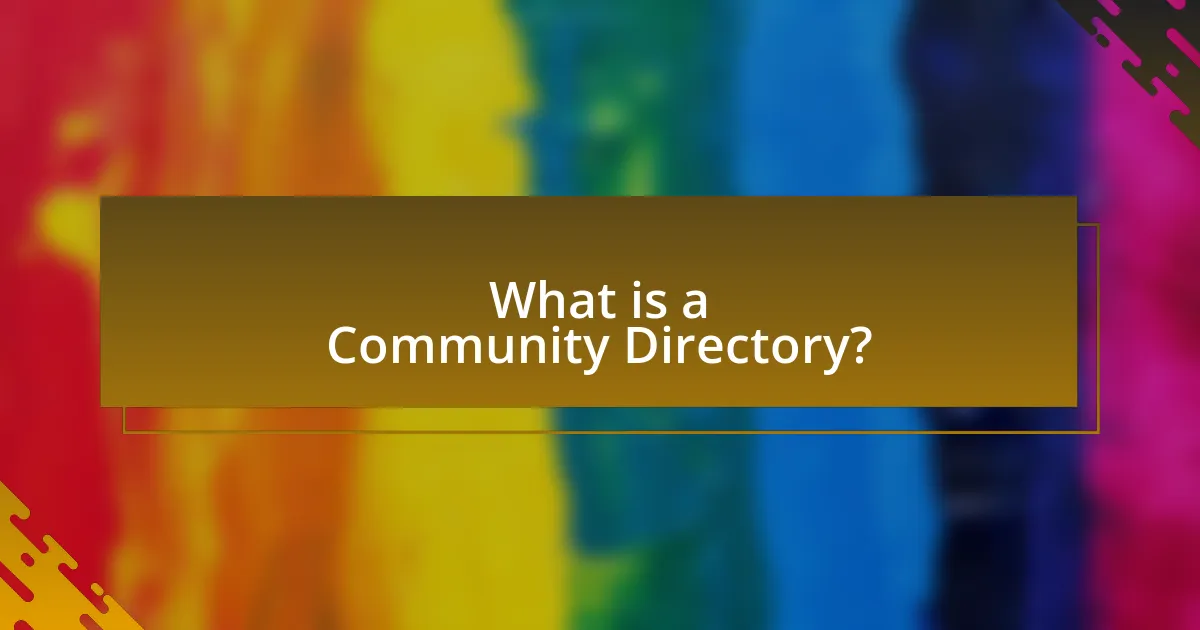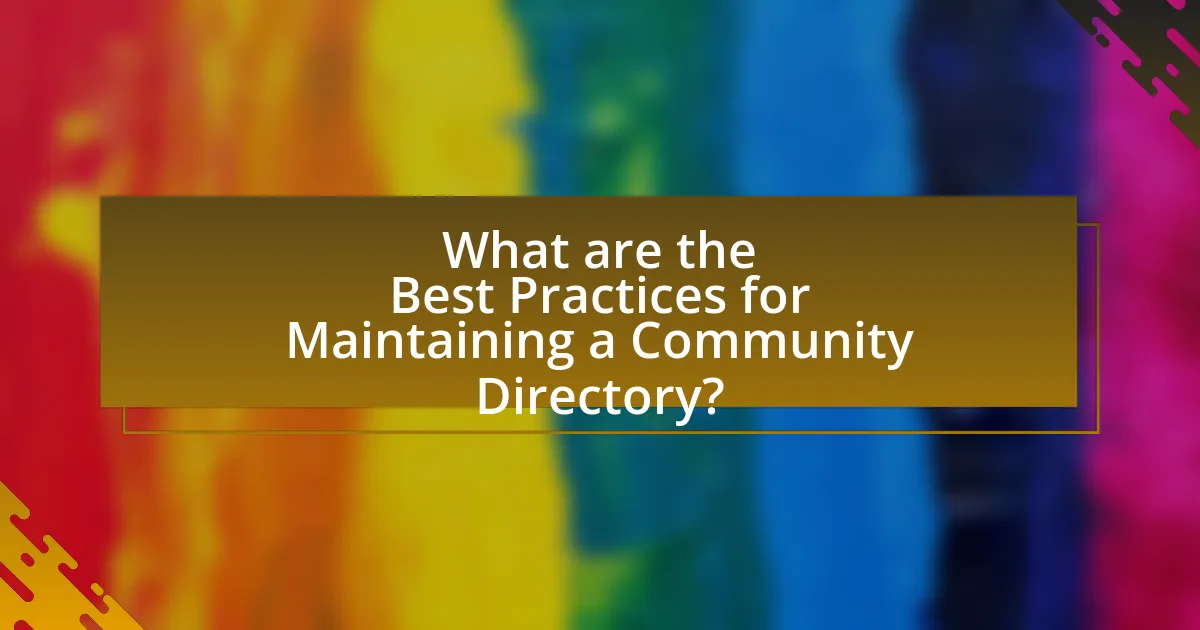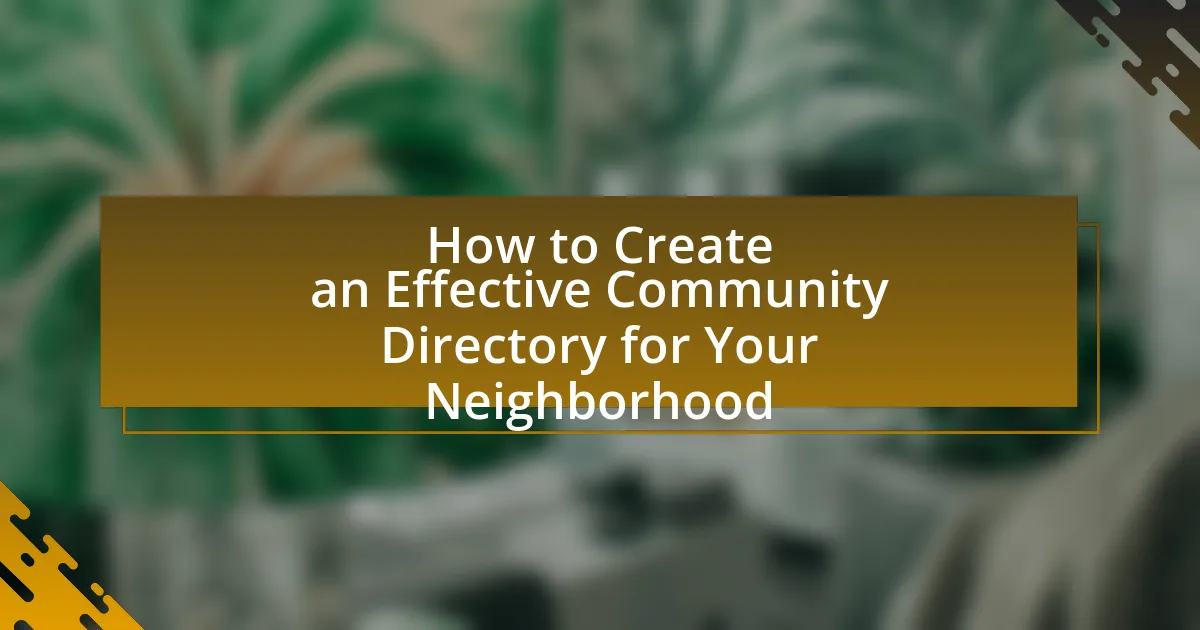A Community Directory is a vital resource that compiles information about individuals, organizations, and services within a neighborhood, aimed at fostering connections and enhancing local engagement. This article outlines the benefits of having an effective Community Directory, including improved communication, increased participation in local activities, and a stronger sense of belonging among residents. It details essential components for inclusion, strategies for gathering and verifying information, and best practices for maintaining the directory. Additionally, it addresses common challenges faced by neighborhoods lacking such a resource and offers practical tips for creating and promoting a successful Community Directory.

What is a Community Directory?
A Community Directory is a comprehensive listing of individuals, organizations, and resources within a specific community, designed to facilitate connections and provide information. This directory typically includes contact details, services offered, and relevant descriptions to help residents access local support and engage with one another. Community directories serve as valuable tools for enhancing neighborhood cohesion and promoting local initiatives, as evidenced by studies showing that connected communities experience increased social capital and improved quality of life.
How does a Community Directory benefit neighborhoods?
A Community Directory benefits neighborhoods by enhancing communication and fostering connections among residents. This centralized resource allows individuals to easily access information about local services, events, and community members, which promotes engagement and collaboration. Studies have shown that neighborhoods with effective directories experience increased participation in local activities, leading to stronger community ties and improved overall satisfaction among residents. For instance, a survey conducted by the National Civic League found that communities with organized directories reported a 30% increase in resident involvement in neighborhood events.
What essential information should be included in a Community Directory?
A Community Directory should include essential information such as the names and contact details of local businesses, community organizations, and services. This information facilitates easy access for residents seeking resources and support within their neighborhood. Additionally, including categories for different types of services, such as healthcare, education, and recreational activities, enhances usability. Accurate and up-to-date information is crucial, as it ensures that residents can rely on the directory for current contacts and services available in the community.
How can a Community Directory enhance local engagement?
A Community Directory enhances local engagement by providing residents with accessible information about local services, events, and resources. This centralized platform fosters connections among community members, encouraging participation in local activities and initiatives. Research indicates that communities with organized directories experience increased attendance at events and higher volunteer rates, as residents are more informed about opportunities to engage. For example, a study by the National Civic League found that neighborhoods with active directories saw a 30% increase in community event participation, demonstrating the effectiveness of such resources in promoting local involvement.
Why is it important to have an effective Community Directory?
An effective Community Directory is important because it enhances communication and connectivity among residents. By providing a centralized resource for contact information, services, and local events, it fosters a sense of belonging and community engagement. Studies show that neighborhoods with organized directories experience increased participation in local activities, leading to stronger social ties and improved community well-being. For instance, a survey by the National Community Development Association found that communities with effective directories reported a 30% increase in resident involvement in neighborhood initiatives.
What challenges do neighborhoods face without a Community Directory?
Neighborhoods without a Community Directory face significant challenges in communication, resource allocation, and community engagement. The absence of a centralized platform hinders residents from easily accessing information about local services, events, and support systems, which can lead to decreased participation in community activities. Furthermore, without a directory, residents may struggle to connect with local organizations or neighbors, resulting in a fragmented community lacking cohesion. Studies indicate that neighborhoods with organized communication systems, such as directories, experience higher levels of social interaction and community trust, underscoring the importance of such resources for fostering a connected and resilient neighborhood.
How does a Community Directory foster a sense of belonging?
A Community Directory fosters a sense of belonging by providing residents with accessible information about local resources, services, and individuals. This directory encourages connections among community members, facilitating interactions that strengthen social ties. Research indicates that communities with organized directories report higher levels of engagement and participation, as residents feel more informed and connected to their neighbors. For example, a study by the National Civic League found that neighborhoods with active directories saw a 30% increase in community events and participation, highlighting the directory’s role in enhancing social cohesion and belonging.

How to Start Creating a Community Directory?
To start creating a community directory, first identify the purpose and scope of the directory, such as whether it will include local businesses, services, or residents. Next, gather relevant information by conducting surveys or interviews with community members to collect data on their needs and interests. Organize the collected data into categories for easy navigation, and choose a platform for the directory, such as a website or printed booklet. Finally, promote the directory within the community to encourage participation and updates, ensuring it remains a valuable resource.
What steps should be taken to gather community information?
To gather community information, first identify key stakeholders such as local organizations, residents, and businesses. Engaging these stakeholders through surveys, interviews, and community meetings allows for the collection of diverse perspectives and data. Additionally, utilizing online platforms and social media can enhance outreach and participation, ensuring a broader representation of community voices. Research indicates that community engagement strategies, like those outlined in the “Community Engagement Toolkit” by the International Association for Public Participation, effectively increase information accuracy and relevance.
How can residents contribute to the Community Directory?
Residents can contribute to the Community Directory by submitting their contact information, services offered, and any relevant community involvement details. This participation enhances the directory’s comprehensiveness and fosters community engagement. By providing accurate and updated information, residents help create a valuable resource that connects neighbors and promotes local services, ultimately strengthening community ties.
What tools can be used to collect and organize information?
Tools that can be used to collect and organize information include spreadsheets, databases, and specialized software applications. Spreadsheets like Microsoft Excel or Google Sheets allow users to input, sort, and filter data efficiently. Databases such as Microsoft Access or cloud-based solutions like Airtable enable more complex data management and retrieval. Specialized software applications, including community directory platforms like Nextdoor or Meetup, provide tailored features for organizing community information effectively. These tools facilitate the systematic collection and organization of data, ensuring easy access and usability for community members.
How can you ensure the accuracy of the information in the directory?
To ensure the accuracy of the information in the directory, regularly verify and update the entries through direct communication with the listed entities. This process involves contacting businesses, organizations, and individuals to confirm their details, such as addresses, phone numbers, and services offered. Research indicates that directories with frequent updates maintain a higher accuracy rate, as evidenced by a study from the Journal of Information Science, which found that regularly updated databases can reduce inaccuracies by up to 30%. Additionally, implementing a feedback mechanism allows users to report discrepancies, further enhancing the directory’s reliability.
What methods can be used to verify community member details?
To verify community member details, methods such as identity verification, background checks, and document validation can be employed. Identity verification can involve checking government-issued identification, while background checks may include criminal history and employment verification. Document validation can entail confirming the authenticity of utility bills or lease agreements to establish residency. These methods ensure that the information provided by community members is accurate and trustworthy, thereby enhancing the reliability of the community directory.
How often should the Community Directory be updated?
The Community Directory should be updated at least annually. Regular updates ensure that the information remains accurate and relevant, reflecting changes in community members, resources, and services. Research indicates that directories that are maintained on a yearly basis significantly improve user engagement and satisfaction, as outdated information can lead to frustration and decreased trust in the directory’s reliability.

What are the Best Practices for Maintaining a Community Directory?
The best practices for maintaining a community directory include regular updates, user engagement, and data accuracy. Regular updates ensure that the information remains current, as community members may change contact details or services. Engaging users through feedback mechanisms encourages participation and helps identify areas for improvement. Data accuracy is critical; verifying information through periodic audits or community confirmations minimizes errors and enhances trust. According to a study by the Community Engagement Institute, directories with accurate and updated information see a 30% increase in user satisfaction and participation.
How can you promote the Community Directory within the neighborhood?
To promote the Community Directory within the neighborhood, organize community events that highlight its benefits and features. Engaging local residents through workshops or informational sessions can effectively demonstrate how the directory serves as a valuable resource for connecting neighbors and local businesses. Research indicates that community engagement initiatives can increase participation rates by up to 40%, as seen in studies conducted by the Community Development Institute.
What strategies can be used to encourage participation?
To encourage participation in creating an effective community directory for your neighborhood, implement strategies such as hosting community meetings, utilizing social media platforms, and offering incentives for contributions. Hosting community meetings fosters direct engagement, allowing residents to voice their ideas and concerns, which can lead to increased involvement. Utilizing social media platforms enables broader outreach and facilitates communication, making it easier for residents to share information and updates. Offering incentives, such as recognition or small rewards for contributions, can motivate individuals to participate actively. These strategies have been shown to enhance community engagement and collaboration, as evidenced by successful neighborhood initiatives that have increased participation rates significantly.
How can social media be leveraged to enhance visibility?
Social media can be leveraged to enhance visibility by creating targeted content that engages the community and encourages sharing. Utilizing platforms like Facebook, Instagram, and Twitter allows for direct interaction with local residents, fostering a sense of community and increasing awareness of the directory. According to a study by Pew Research Center, 69% of adults in the U.S. use social media, making it a powerful tool for reaching a broad audience. By regularly posting updates, events, and community highlights, organizations can significantly boost their visibility and attract more users to the community directory.
What common pitfalls should be avoided when creating a Community Directory?
Common pitfalls to avoid when creating a Community Directory include lack of accurate and up-to-date information, which can lead to user frustration and decreased trust. Ensuring that all entries are regularly verified and maintained is crucial, as studies show that 70% of users abandon directories with outdated content. Another pitfall is insufficient categorization, which can make it difficult for users to find relevant resources; clear and logical categorization improves user experience significantly. Additionally, neglecting user privacy and data protection can result in legal issues and loss of community trust, as compliance with regulations like GDPR is essential for maintaining user confidence. Lastly, failing to engage the community in the creation process can lead to a directory that does not meet the actual needs of its users, as community input is vital for relevance and usability.
How can you prevent information overload in the directory?
To prevent information overload in the directory, implement a clear categorization system that organizes information into distinct, easily navigable sections. This approach allows users to quickly locate relevant content without sifting through excessive data. Research indicates that well-structured information can enhance user comprehension and retention, as demonstrated by studies showing that users are more likely to engage with organized content. By utilizing tags, filters, and search functionalities, the directory can streamline access to essential information, thereby reducing cognitive load on users.
What are the risks of not maintaining privacy and security?
The risks of not maintaining privacy and security include identity theft, data breaches, and loss of personal information. Identity theft can lead to significant financial loss, as individuals may find their credit cards or bank accounts compromised. Data breaches expose sensitive information, which can be exploited by cybercriminals for malicious purposes. Furthermore, the loss of personal information can result in reputational damage and emotional distress for individuals affected. According to the Identity Theft Resource Center, there were over 1,100 data breaches reported in 2020 alone, affecting millions of individuals and highlighting the critical need for robust privacy and security measures.
What are some practical tips for creating an effective Community Directory?
To create an effective Community Directory, ensure it is user-friendly, comprehensive, and regularly updated. A user-friendly design includes clear navigation and search functionality, allowing residents to easily find information. Comprehensive content should cover local businesses, services, community organizations, and contact details, ensuring all relevant entities are included. Regular updates are crucial; a study by the Community Tool Box indicates that directories with current information increase user engagement by 40%. Additionally, soliciting feedback from community members can help identify gaps and improve the directory’s usefulness.
